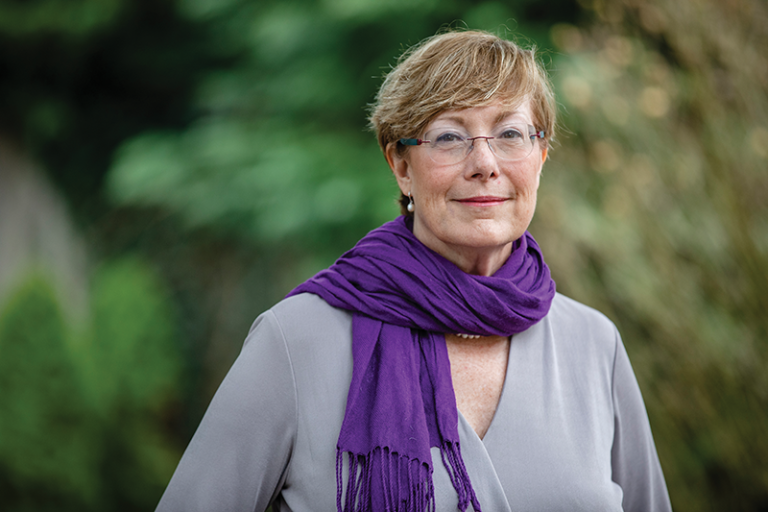How Physical Activity Benefits Cancer Patients
The field of exercise oncology is bringing improved health and hope to survivors of breast cancer
- 12 minute read
- Feature

The oars slice in and out of the water in unison as the boat glides downstream. To an observer, it looks like any other group of rowers enjoying a sunny day on the Charles River. But this all-female team of athletes has more than their love of rowing in common: They are all breast cancer survivors, bound together by their desire to stay strong and active.
These women, and their peers in boats across the country, have long understood through lived experience that regular exercise has powerful effects on both the bodies and minds of people with cancer. Today, science is finally catching up with them.
Just a few decades ago, advice to cancer patients, particularly those undergoing chemotherapy, centered on rest: Take it easy. Avoid strenuous activity, especially aerobic exercise. At the time, the recommendation seemed logical. Allowing the body to rest might also allow it to heal, experts thought, while physical activity might worsen fatigue, pain, and other symptoms.
This thinking began to change in the late 1980s, when a pair of oncology nurses at The Ohio State University undertook what was then a radical experiment. Curious to see whether conventional wisdom on exercise avoidance held true, they randomly sorted forty-five breast cancer patients who were undergoing chemotherapy into a group that participated in ten weeks of aerobic exercise training or into a control group. The findings of this landmark study were stunning: Not only was exercise safe and feasible during cancer treatment, it was also associated with improvements in weight, body composition, and nausea symptoms. The small trial served as a catalyst for future investigations, ultimately leading to a new field of study: exercise oncology.
Subscribe to Harvard Medicine magazine
In 2010, researchers and clinicians gathered at an interdisciplinary meeting to review the evidence on the safety of exercise in people living with cancer. The resulting American College of Sports Medicine (ACSM) Roundtable report—one of the first of its kind—advised cancer survivors to avoid inactivity.
Eight years later, the roundtable met again to assess the data; that assessment led the group to expand its recommendations to include the role of exercise in cancer prevention, control, and survivorship. The guidelines offer a powerful prescription for people with cancer. The evidence to support these guidelines is overwhelmingly reassuring: Studies suggest that regular physical activity is associated with fewer or milder side effects from chemotherapy, improved quality of life, and even lower odds of cancer recurrence and mortality. While research continues, leading investigators in the field say that every physician and other health care provider should consider prescribing exercise to their patients with cancer.
“We’re at the point where we know exercise is an evidence-based treatment with robust effects,” says Kathryn Schmitz, a researcher at the Penn State Cancer Institute who chaired the ACSM’s roundtables. “If we don’t prescribe it, when does that become malpractice?”

Weighty issues
Since exercise oncology’s infancy, much of the research in the field has focused on breast cancer. That’s largely because of the prevalence of the disease, which, according to a 2020 NIH report, is the most common type of cancer among women in the United States. It also affects about 1 percent of men and can occur in transgender and nonbinary people assigned female at birth.
As with some other cancers, the conditions of overweight or obesity can heighten the risk for breast cancer in postmenopausal women. Indeed, one recent meta-analysis of eighty-two studies found that the risk of dying from breast cancer was 35 percent higher among women who were affected by obesity at the time of their diagnosis, compared to the mortality risk for women who were within standard weight ranges.
Although researchers are still unraveling the relationship between weight and breast cancer, hormones appear to be an important link. In postmenopausal women, fat cells play an important role in the production of estrogen, which can spur tumor growth in hormone receptor-positive breast cancers, says Elizabeth (Betsy) O’Donnell, an HMS assistant professor of medicine at Massachusetts General Hospital and director of the hospital’s Lifestyle Medicine Clinic. Body fat can also trigger chronic low-grade inflammation, a state shown to stimulate the growth of breast cancer cells in postmenopausal women.
These factors “uniquely position” exercise as an “intervention to manage body weight for risk reduction and improved outcomes in women with breast cancer,” says Christina Dieli-Conwright, an HMS faculty of medicine member who studies the effect of personalized exercise interventions on cancer outcomes at Dana-Farber Cancer Institute. Most of the seminal research in this area has involved breast cancer, she says, “in part because of the volume of patients we can recruit.”
From the 1990s to the mid-2000s, the majority of research examined the effects of physical activity on the quality of life in women living with breast cancer, particularly those undergoing treatment for the disease. The 2010 ACSM roundtable, which drew mainly from studies of people with breast or prostate cancer, determined that exercise training was generally safe and well-tolerated both during and after cancer treatment. Beyond safety, the panel found sufficient evidence to conclude that exercise could elicit improvements in physical fitness, physical functioning, and quality of life and decrease fatigue in patients with cancer.
By 2018, the data on these topics were sufficient to allow the ACSM roundtable to develop evidence-based prescriptions for the frequency, intensity, time, and type (FITT) of exercise best suited to specific cancer-related health outcomes. The panelists, in fact, found strong or moderate evidence to issue FITT prescriptions for eight such outcomes: anxiety, depressive symptoms, fatigue, quality of life, lymphedema, physical function, bone health, and sleep. Most of the FITT prescriptions entail moderate aerobic activity, often combined with resistance training, several times a week. Similarly, the American Cancer Society recommends that people with cancer remain as active as possible during treatment and aim for at least 150 minutes of activity a week once their disease is stable or in remission.

“The evidence we have clearly suggests that exercise can help mitigate the toxicities of cancer treatment,” explains Jennifer Ligibel, an HMS associate professor of medicine at Dana-Farber and director of the cancer institute’s Leonard P. Zakim Center for Integrative Therapies and Healthy Living. “Our message should be that exercise is a goal for all cancer survivors.”
The promise of such benefits is what draws many patients to the Zakim Center and the Lifestyle Medicine Clinic at Mass General. Both practices offer exercise and nutritional consultations, as well as other complementary approaches aimed at helping to improve quality of life and attenuating treatment side effects in people with cancer. At O’Donnell’s clinic, women with breast cancer make up roughly 90 percent of referrals. Many of the women are driven by a desire to shed pounds following their diagnosis, but more than that, they want a sense of control. “These patients want to know what they can do on their own to feel better,” Ligibel says. “Our goal is to help them live the best life that they can after cancer diagnosis.”
Define the promise
Exercise may help address the side effects of breast cancer treatment, but could it also help prevent the disease? Could it even stop it in its tracks? These are some of the intriguing questions that some researchers now hope to answer.
“Overall, the field is moving to dig deeper into the effect on clinical outcomes,” says Dieli-Conwright. “Now that we know exercise can successfully address quality of life during cancer treatment, we’re looking to see whether it can also improve treatment efficacy.”
The evidence to date is promising. Engaging in moderate-intensity aerobic exercise for at least 150 to 300 minutes a week and adding in resistance training twice a week appears to lower the risk of mortality from breast, colorectal, and prostate cancers by up to 50 percent. The 2018 ACSM roundtable also confirmed the role of physical activity in helping to prevent several types of cancer, including breast, colon, endometrial, kidney, bladder, esophageal, and stomach. The same panel concluded that regular exercise both before and after diagnosis might improve survival in people with breast or colon cancer. Interestingly, data hint that physical activity following diagnosis may provide greater mortality benefits than exercise before diagnosis.
This suggests that cancer patients might have a window of time during which exercise training could influence the course of their disease, says Ligibel. In a 2019 study that appeared in Clinical Cancer Research, she and her colleagues conducted a randomized study that looked at the effects of an exercise intervention beginning about a month before surgery in twenty-seven sedentary women with newly diagnosed breast cancer compared with another twenty-two sedentary women with newly diagnosed breast cancer in a control group. They found that, although exercise training didn’t appear to influence cancer cell proliferation, women randomized to exercise experienced changes in gene expression in the tumors they had and women randomized to the control group did not. This, says Ligibel, suggests that exercise may have a direct effect on breast cancer—even when started after diagnosis.
Ongoing research by Ligibel and others promises to shed even more light on the topic. Her largest undertaking—the Breast Cancer Weight Loss study, known as the BWEL study—will evaluate the effect of weight loss after diagnosis on risk of breast cancer recurrence. The phase 3 study, which enrolled some 3,200 women diagnosed with stage II or III hormone receptor-positive or triple-negative breast cancer, has randomized participants to a health education program either alone or combined with a two-year diet and exercise program. “Our hope is that we’ll learn whether weight loss can reduce the risk of cancer recurrence and improve survival in women with breast cancer,” she says.

More research is needed to determine exactly how weight loss and exercise might influence cancer prevention and survival. Clues point to certain pathways in tumor growth, including insulin and insulin-like growth factor 1, high levels of which are associated with an increased risk of several cancers. Work by Ligibel, Dana-Farber medical oncologist and HMS Professor of Medicine Jeffrey Meyerhardt, and others has looked at the effect of exercise, the insulin-sensitizing drug metformin, or both on outcomes in breast and colorectal cancer survivors. So far, their findings suggest that the combination of exercise and metformin appears to reduce levels of metabolic markers and inflammation associated with cancer recurrence and mortality.
Just do it
Yet even as they look to the future of exercise oncology, investigators acknowledge that physical activity is useful only if people engage in it. “No matter how sexy the science is, we just need people to move,” says Dieli-Conwright.
That can be particularly challenging for breast cancer patients, some of whom may never have exercised regularly before. Others may have been active previously but have fallen out of their exercise routines during cancer treatment. O’Donnell, herself a cyclist, understands that most women aren’t likely to adopt her habit of cycling nearly 40 miles round trip to work every day. Instead, she and her colleagues focus on giving cancer patients a boost and breaking down barriers to exercise.
“It can be hard to maintain physical activity if it isn’t built into your life,” she explains. “And if you’ve never exercised, you don’t know what’s out there that you might like.” To help, she works with patients to identify forms of exercise that interest them—perhaps a patient hates running but loves to dance, for example—and then create new routines that make activity a habit. She’s also created a series of videos to introduce patients to exercise, which she provides free of charge to help acknowledge the financial toxicity of a cancer diagnosis.
But half the battle may be encouraging physicians to prescribe exercise to patients in the first place, says Schmitz. “Medical oncologists tell me that they know exercise is beneficial but don’t refer for exercise because they don’t have time to discern which patients can safely do it,” she says.
In 2019, Schmitz and her colleagues issued a call to action for medical oncologists, urging them to assess the physical activity of their patients, advise patients on desired levels of physical activity, and refer patients to appropriate exercise programs. “Preserving activity and functional ability is integral to cancer care, and oncology clinicians are key to providing these referrals,” they wrote in the October 2019 issue of CA: A Cancer Journal for Clinicians. Indeed, one recent study found that referrals by medical oncologists for exercise training increased from 20 percent to 70 percent when a cancer exercise specialist was embedded in the hospital’s chemotherapy suite. The experiment also proved cost-effective, with the price of screening averaging just one dollar per patient.
According to Schmitz, the key to success may require drawing on existing resources. “Referring for exercise can’t just be another damn thing for medical oncologists to do,” she says. “They already have enough on their plates.”
Rather than building new infrastructure, she recommends seeking inspiration from existing clinical pathways. Case in point: psychosocial distress screening, used by medical oncologists to identify anxiety, depression, and other symptoms of cancer-related distress. A similar clinical care pathway could be created to help medical oncologists identify which patients can safely engage in exercise, says Schmitz.
Jumping off point
Looking to the future, investigators hope to further home in on the specifics of prescribing exercise for breast and other cancers. Areas of study include learning more about the benefits of exercise in its many forms, as well as parsing its effects on the many subtypes of breast cancer and determining the ideal “dose” of physical activity for individual patients.
“We’re at a really wonderful moment in the field of exercise oncology where we have enough evidence to prescribe exercise, but we still have so much more to learn,” says Schmitz. “The fact that we’ve had some successes doesn’t mean we’re done—far from it. There’s a whole career’s worth of investigation left to do in this field.”
Jessica Cerretani is a Boston-based writer.
Images: Dung Hoang (illustration); Amanda Berg (Schmitz); Kelly Davidson (O’Donnell); John Soares (Ligibel)